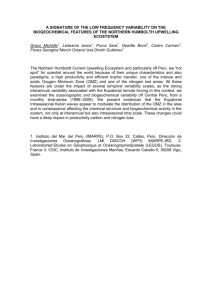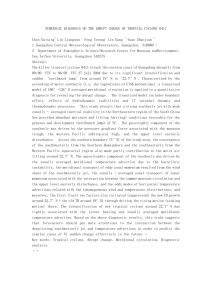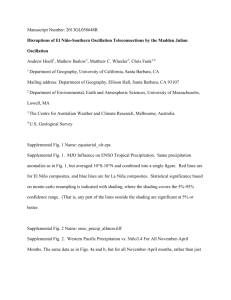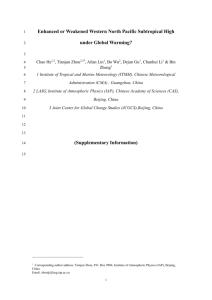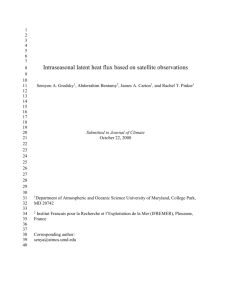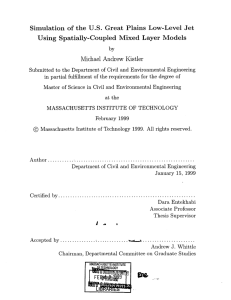grl28388-sup-0002-txts01
advertisement
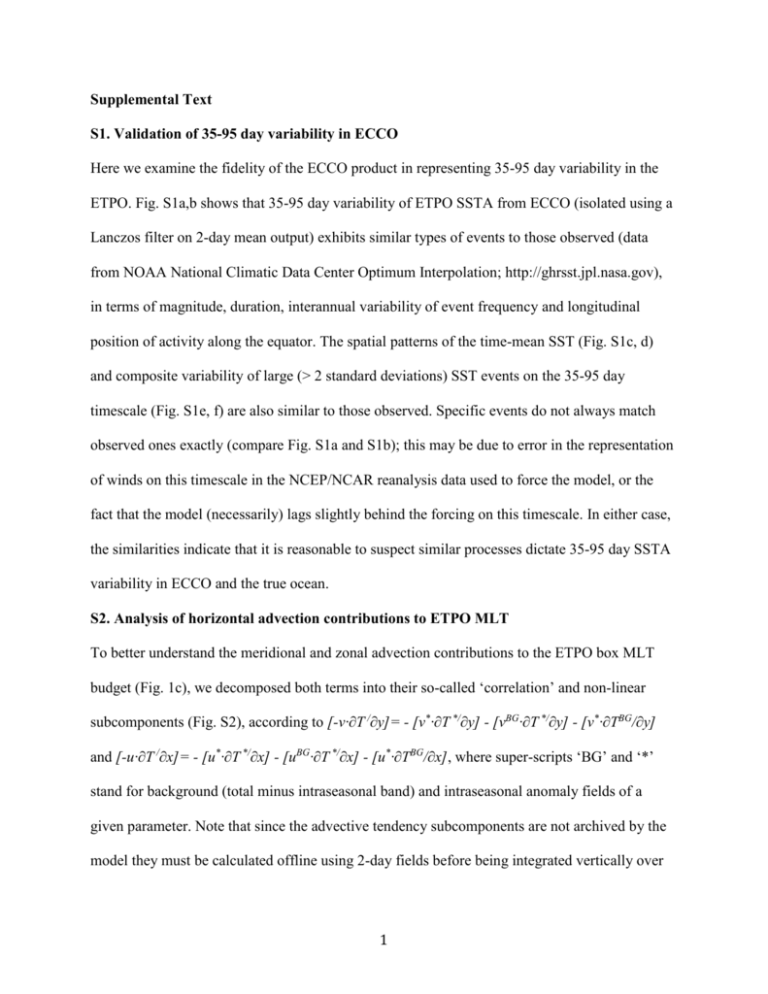
Supplemental Text S1. Validation of 35-95 day variability in ECCO Here we examine the fidelity of the ECCO product in representing 35-95 day variability in the ETPO. Fig. S1a,b shows that 35-95 day variability of ETPO SSTA from ECCO (isolated using a Lanczos filter on 2-day mean output) exhibits similar types of events to those observed (data from NOAA National Climatic Data Center Optimum Interpolation; http://ghrsst.jpl.nasa.gov), in terms of magnitude, duration, interannual variability of event frequency and longitudinal position of activity along the equator. The spatial patterns of the time-mean SST (Fig. S1c, d) and composite variability of large (> 2 standard deviations) SST events on the 35-95 day timescale (Fig. S1e, f) are also similar to those observed. Specific events do not always match observed ones exactly (compare Fig. S1a and S1b); this may be due to error in the representation of winds on this timescale in the NCEP/NCAR reanalysis data used to force the model, or the fact that the model (necessarily) lags slightly behind the forcing on this timescale. In either case, the similarities indicate that it is reasonable to suspect similar processes dictate 35-95 day SSTA variability in ECCO and the true ocean. S2. Analysis of horizontal advection contributions to ETPO MLT To better understand the meridional and zonal advection contributions to the ETPO box MLT budget (Fig. 1c), we decomposed both terms into their so-called ‘correlation’ and non-linear subcomponents (Fig. S2), according to [-v∙∂T /∂y]= - [v*∙∂T */∂y] - [vBG∙∂T */∂y] - [v*∙∂TBG/∂y] and [-u∙∂T /∂x]= - [u*∙∂T */∂x] - [uBG∙∂T */∂x] - [u*∙∂TBG/∂x], where super-scripts ‘BG’ and ‘*’ stand for background (total minus intraseasonal band) and intraseasonal anomaly fields of a given parameter. Note that since the advective tendency subcomponents are not archived by the model they must be calculated offline using 2-day fields before being integrated vertically over 1 the ML; this causes small errors relative to the meridional and zonal advection tendencies derived directly from the model output (in Fig. 1c). Fig. S2a shows that for our composite event, the meridional advection term is dominated by - [v*∙∂TBG/∂y], representing the advection of the meridional gradient of the background temperature field by the intraseasonal meridional current. This aspect is qualitatively consistent with both L10 and M02, although those studies differed dramatically on the relative importance of meridional advection compared to the other budget terms. Fig. S2b (S2c) shows that intraseasonal meridional currents cause convergence (divergence) along the equator over a largescale region containing our box during the warming (cooling) maxima of the composite event; since the background temperature is lowest along the equator, both the cooling and warming phases are reinforced by meridional advection. These maps also suggest that the smaller relative amplitude of the meridional advective tendency in M02 compared to that in our study could be due to the fact that the meridional temperature gradient at the center of the box is weaker than the meridional temperature gradients at the northern and southern boundaries of the larger box that we use. However, replication of this analysis for the 1°x0.6° sector centered at (110°W, EQ), and for slightly varied subregions consisting of 1 or more grid cells near the center of this box (not shown), tends to produce curves that vary significantly depending on which grid cells are chosen. This appears to be partly due to some spatial deviations of the intraseasonal meridional current very close to equator. The zonal advection contribution to the full box MLT budget (Fig. S2d) is controlled largely by - [uBG∙∂T */∂x] during both phases; this represents advection of the zonal gradient of the intraseasonal temperature anomaly by the zonal background current, illustrated in Fig. S2e and S2f for the warming and cooling phase extrema, respectively. This differs qualitatively from M02, which found - [u*∙∂TBG/∂x] (advection of the zonal gradient of the background MLT by the 2 intraseasonal zonal current) to be the most significant zonal subcomponent at 110°W. However, analogous decompositions of the zonal advection term for the 1°x0.6° sector centered at (110°W, EQ), for small variations on this sector within the box, and for progressively larger boxes around that sector (not shown) suggest this difference between ECCO and the M02 study is due at least partly to differences between the larger-scale spatial-mean state and conditions at the point location right at the equator, in particular, due to spatial deviations of the intraseasonal fields very close to the equator. This is consistent with the finding by Wang and McPhaden (1999), Kim et al. (2007), and others that dominant physical mechanisms in a process budget can be scale dependent. S3. Effects of Interannual Thermocline Variability It is interesting to note that significant interannual variability still exists in the ETPO SSTA after the 35-95 day Lanczos bandpass filter is applied (e.g. Fig. S1a, b). Interannual variability of intraseasonal variations in the ETPO is recognized by other authors (e.g., Zhang 2001), and hypotheses have been proposed regarding how intraseasonal variations may modulate or work in conjunction with interannual variability (e.g., McPhaden 1999; Zhang 2001). It may also be useful to consider whether interannual preconditioning of the vertical structure by thermocline forcing helps to characterize a typical 35-95 day event. Fig. S4 shows the non-seasonal variability (seasonal cycle removed) of the vertical temperature structure averaged over the ETPO box during 1993-2008 (period of the entire model simulation). The black vertical lines represent center-points of the 17 positive MLT events that are used in our composite. It is evident that most of these events occur during periods exhibiting significant shoaling of the 20°C isotherm on the interannual timescale. Thus, it is likely that pre-conditioning of the vertical structure by interannual thermocline variability enhances sensitivity of ETPO MLT to forcing on the 35-95 day timescale. 3 Supplementary Figures Figure S1: ECCO versus observed SST from the NOAA National Climatic Data Center level 4 Optimum Interpolation with Advanced Very High Resolution Radiometer data (http://ghrsst.jpl.nasa.gov; Reynolds and Smith 1994), including (a, b) time-longitude plots of 35-95 day filtered SSTA (black vertical lines at 120 and 100°W indicate position of ETPO box in later panels); (c, d) the time mean fields of SST; (e, f) Hovmöller diagrams of composite 3595 day SSTA. Figure S2: Panels (a) and (d): Decompositions of meridional and zonal, respectively, advective tendency terms from Fig.1c into their so-called ‘correlation’ and non-linear subcomponents. Panels (b, c): maps of intraseasonal meridional ML current (MLV) and background MLT distributions during the warming and cooling phase maxima, respectively, of the composite event; together these illustrate, –[v*∙∂TBG/∂y], the dominant meridional advection subcomponent during each phase; (e, f) maps of background zonal ML current (MLU) and intraseasonal MLT distributions during the warming and cooling phase maxima; together these illustrate, – [uBG∙∂T */∂x], the most important zonal subcomponent. Figure S3: Intraseasonal (35-95 day) surface wind stress forcing averaged spatially over (120100°W, 3°S-3°N) and composited for time periods corresponding to those of the MLT events included in the MLT budget (Fig. 1). Winds are the smoother-adjusted NCEP-COADS blended wind fields used to force the final ECCO solution (described in section 2.1). Figure S4: Non-seasonal (seasonal cycle removed only) vertical temperature structure during 1993-2008 from ECCO. Vertical black lines show center-points of large 35-95 day events (when the positive MLT anomaly is at maximum amplitude) included in the composite event. 4 5
